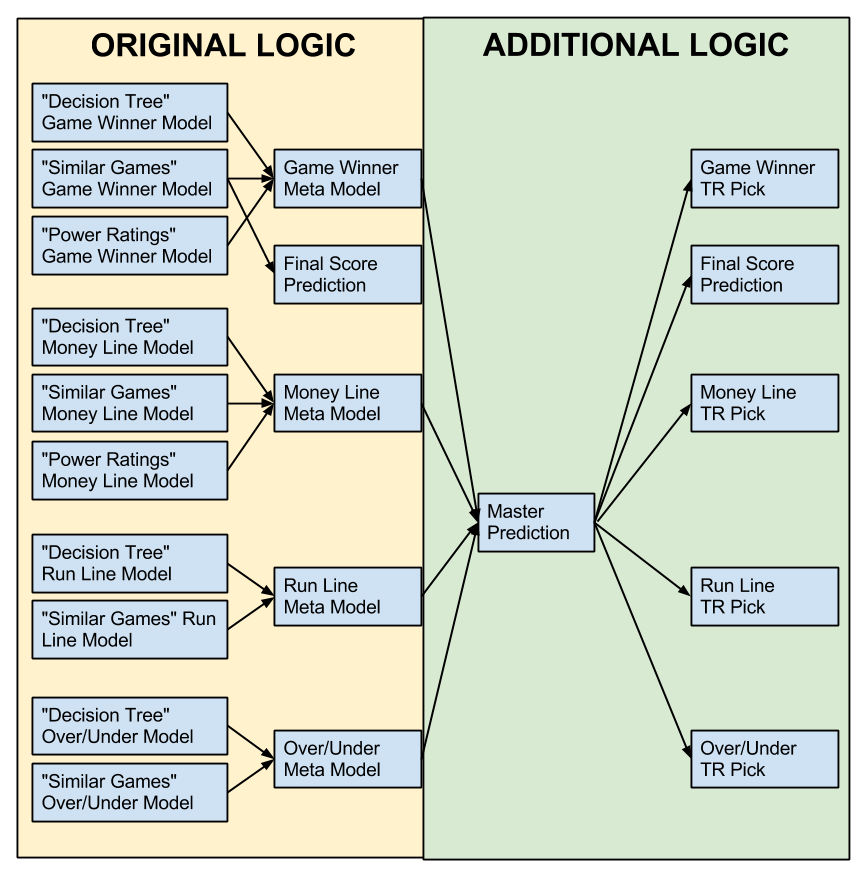Site Update: Enhanced 2013 MLB Pick Logic Released
April 17, 2013 - by David Hess
Researching and improving our prediction models is an ongoing process, and one to which we devote significant time. The past year has been particularly active, though, as we’ve been rolling out significant pick logic updates to all of our sports. These updates are primarily designed to eliminate a long-standing source of user confusion, conflicting picks, but they should also help to improve our long term pick accuracy.
MLB is the latest (and final) sport to join the club. So, what’s new?
Creation Of A Master Game Prediction
For a long time, we’ve had completely separate models for game winner picks, run line (or point spread) picks, money line picks, over/under picks, and final score predictions. Why? Because it’s typically more effective to optimize a model to achieve one goal. If your primary goal is to pick point spread winners, that’s all you care about. You should use a model that is the best at predicting against the point spread, even if it isn’t one of the best models for predicting straight up game winners.
If we set out to design one model to predict both game winners and point spread winners, from the get-go, we’d have trade-offs to make. Some calibrations of the model might be pretty good at predicting both game winners and point spread winners, other approaches could end up being great at predicting one of those two things, but not so great at predicting the other. As a result, we stuck with the multiple, focused models approach.
One down side, though, is that independent models don’t always agree. In the past, this inevitable reality has led to some conflicts. For example, in MLB, our game winner model might predict one team has an edge, while the TR money line value pick is finding value on the other side, in a way that doesn’t make sense if you consider the game winner prediction odds. In basketball, our game winner model logic may favor a 1-point underdog to win the game outright, while our point spread model is siding with the 1-point favorite to cover.
Those days are over. In all of our sports, including MLB, we now combine information from all of our model types to create one master prediction for each game, which is then used to create picks against each type of line. Here’s a flow chart for those of you who are visual thinkers (using MLB as the example):
One of the main benefits of this change is that there will no longer be any conflicting picks across pick types.
Incorporation of New Predictive Factors & Weights
Besides eliminating pick conflicts, this new master logic should also help improve pick accuracy. We’ve done more analysis of our historical pick data to find which models perform best under certain conditions, and given them more weight when combining the models. In some cases, that means relying 100% on a single model that has performed well, while in other cases we mix together information from several models.
The general point here is that a “model of models” approach can often be very effective. Even if no individual base model (i.e. Decision Tree, Similar Games, Power Ratings) is outstanding at making, say, MLB over under picks, looking at the set of their predictions as a whole and potentially incorporating other contextual variables about a game can produce profitable long term performance for the TR picks.
No Change To Picks Pages
This is purely a behind-the-scenes change to our prediction model logic. The visual look of the picks pages won’t change.
The MLB game winner picks, MLB money line picks, MLB run line picks, and MLB over-under picks pages will still show our official TR Pick, along with an Odds or Value column showing how likely a team is to win or cover, or how much of an edge they have against a line. And all of those picks pages will still show the base predictions of the individual models for that pick type (Decision Tree, Similar Games, and/or Power Ratings).
The MLB predictions grid page will also remain unchanged.
Logic Updates Are Already In Action
This blog post is actually coming post-facto, as we rolled out this new logic during the evening on Thursday, April 11th. So if you’ve been following our MLB picks over the last few days, you’ve already been seeing the new logic changes in action.
It’s still way too early to make any conclusions — we’ll see where we end up at the end of the 2013 season — but the results have been good so far. From when the new logic was released until this morning (so, games on 4/12/2013 through 4/16/2013), our playable MLB picks of all pick types have gone 56-47 for a gain of +7.2 units.
In comparison, our best individual raw model (Decision Tree) was 55-68 over that span, for a loss of approximately -20 units (we didn’t run an exact unit count there, as that win-loss record kind of speaks for itself).
This is a very small sample size, and you shouldn’t assume the picks will perform the same over the next five day stretch, or the one after that. But it’s at least good to confirm that there doesn’t seem to be any grievous errors in the new logic that wiped out a bunch of good results from our previous approach.
If you’ve got any questions about the change, please fire away in the comment section below. Also, as a final note, now that it’s been two weeks since opening day and we’ve rolled out our prediction model enhancements for the 2013 MLB season, our free MLB trial period for new TR users will be ending tomorrow (Thursday 4/18).
Printed from TeamRankings.com - © 2005-2024 Team Rankings, LLC. All Rights Reserved.
